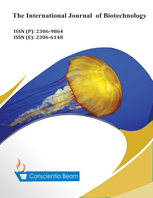Antibacterial Sensitivity Profile of Lactobacillus Species and Characterization of Aflatoxin Producing Fungi Isolated from Yam and Plantain Flour
DOI:
https://doi.org/10.18488/journal.57.2020.91.14.23Abstract
This study investigated the beneficial effects of fermenting microorganisms as well as the presence of aflatoxins in milled flour samples. Thermotolerance, pH tolerance, phenol tolerance, temperature sensitivity, in-vitro antimicrobial potentials of lactic acid bacteria (LAB) isolates and aflatoxin detection in the milled flour sample were analyzed. LAB isolates were identified and characterized as Lactobacillus species using standard procedures. Probiotic properties and antimicrobial activity of LAB isolates were investigated using standard methods. In addition, quantitative and qualitative detection of aflatoxins in the milled flour samples were also studied. The results showed that all the LAB isolates were Lactobacillus species which survived in high temperature range of 50 0C-60 0C, acidic pH (pH 2, 3, 4 and 5), phenol tolerance (0.1%, 0.2%, 0.3% and 0.4%). In -vitro antimicrobial properties of the LAB species (PSEO1 and PSEO4) showed that they were able to inhibit the growth of Escherichia coli(ATCC 43816) and Klebsiella pneumoniae(25922) with the corresponding zones of inhibition: 25mm and 20 mm. Due to the effect of storage time (6 months), yam and plantain flour samples moisture content yielded 9.50% and 9.20% with the corresponding total number of aflatoxins: 859.3 and 899.0. In conclusion, LAB species isolated from yam and plantain flour samples have probiotic potentials. Moreover, the longer the storage time, the higher the number of aflatoxins. Thus, they should be consumed within the shortest time possible to avoid caking and moisture accumulation which tends to decrease the number of beneficial microbes present in them.

